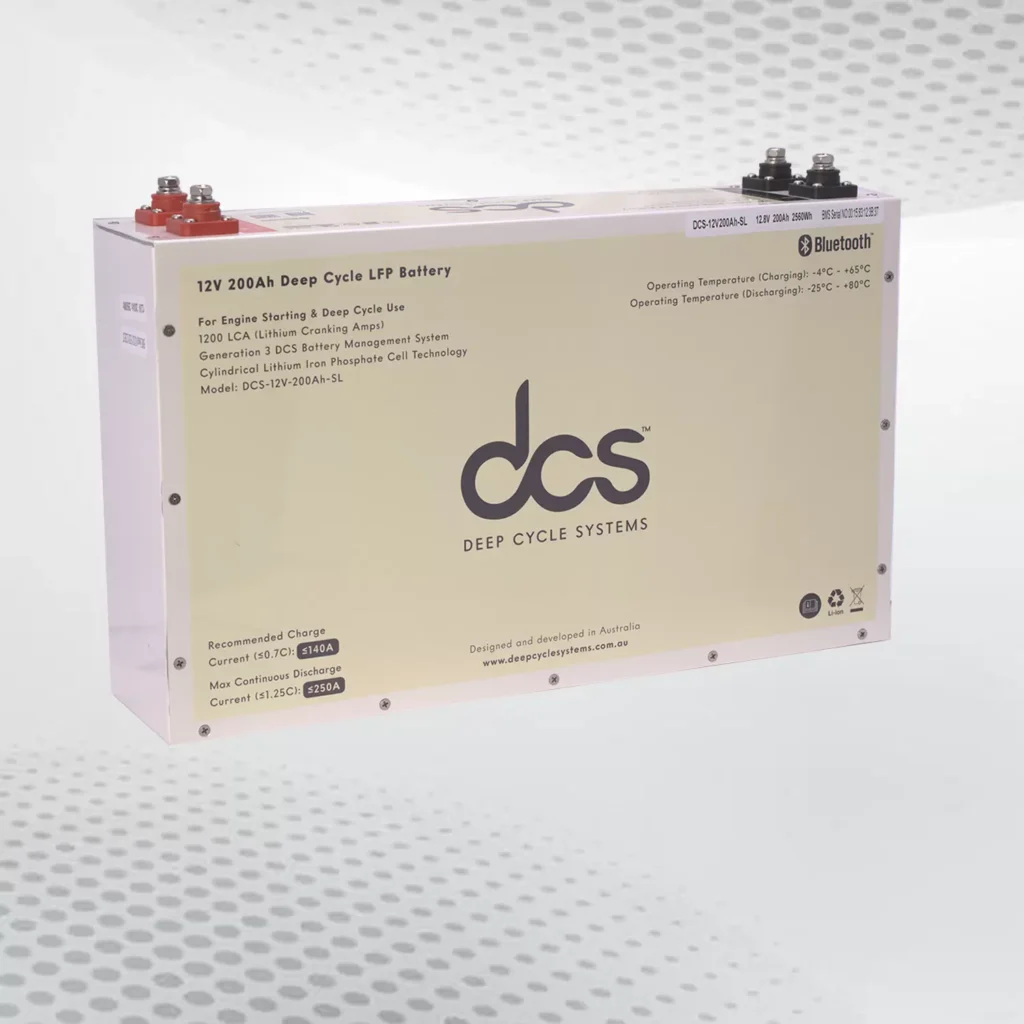In today’s quest for dependable and long-lasting energy solutions, the 200Ah deep cycle battery emerges as an optimal choice. These batteries are engineered to provide stable power over extended periods, making them suitable for various uses. From recreational vehicles to solar energy systems and marine environments, the 200Ah deep cycle battery offers a versatile and robust option. This blog post explores the primary features and performance metrics of these batteries. Additionally, it addresses key considerations for maintenance, selecting the right model, and understanding their role in promoting environmental sustainability.
Key Features of a 200-Ah Deep Cycle Battery
A 200Ah deep-cycle battery stands out for its substantial capacity, providing a reliable and steady power supply over extended periods. This makes it ideal for applications requiring long-term energy storage. The ampere-hour (Ah) rating is crucial as it indicates the battery’s ability to deliver a specific current over time. For instance, a 200Ah battery can provide 200 amps for one hour or 20 amps for ten hours, highlighting its flexibility in different scenarios.
Another key feature is the battery’s design, which handles repeated charging and discharging cycles without significant degradation. Unlike regular batteries, deep cycle variants are constructed with thicker plates and robust separators to withstand frequent cycling, enhancing durability. They often come with advanced safety features, such as built-in protection against overcharging and overheating, ensuring safe operation in various conditions.
The materials used in these batteries are also designed for efficiency and longevity. High-quality lead or lithium cells are commonly employed, offering improved energy density and reduced self-discharge rates. This ensures the battery maintains its charge over extended periods when not in use, providing reliable performance when needed.
Such features make the 200ah deep-cycle battery versatile and dependable for numerous applications.
Battery Lifespan and Performance of 200ah Deep Cycle Battery
Various factors influence the lifespan and performance of a 200ah deep cycle, including the quality of its construction and how it is utilised. These batteries are typically designed to endure numerous charge and discharge cycles, with some models capable of maintaining high efficiency over thousands of cycles. Premium materials, such as high-grade lead or lithium cells, contribute to their extended lifespan and consistent performance.
Performance metrics often focus on the battery’s ability to retain capacity and deliver stable power throughout its operational life. Regular use under optimal conditions can help sustain performance levels, whereas exposure to extreme temperatures or improper charging practices can lead to quicker degradation. Implementing best practices in battery care, such as avoiding complete discharges and using compatible chargers, can significantly enhance lifespan and performance.
Additionally, technological advancements have led to the development of batteries with improved cycle life and energy density, making modern 200ah deep-cycle batteries more reliable than their predecessors. These enhancements ensure the battery remains a viable power source for applications that demand long-term energy storage and dependable performance.
Charging and Maintenance Best Practices
Proper 200ah deep-cycle battery management is essential to maximise its performance and longevity. Selecting a charger compatible with the battery’s specifications is crucial to avoid overcharging, which can diminish capacity and shorten lifespan. Regular maintenance involves checking the electrolyte levels, especially in lead-acid variants, to ensure they remain within the recommended range. Clean terminals are vital for maintaining good electrical connectivity; corrosion can be mitigated using appropriate terminal protectors or regular cleaning with baking soda and water.
It’s important to store the battery in a cool and dry environment away from extreme temperatures, as heat can accelerate degradation. Avoiding complete discharges by recharging when the battery reaches about 50% capacity can significantly enhance its lifespan. Utilising a multi-stage charger that provides bulk, absorption, and float charging stages can help maintain optimal battery health. Monitoring the battery’s state of charge and using a battery management system (BMS) can further ensure that it operates within safe parameters.
Regular inspections for signs of wear or damage are advisable, as early detection can prevent more severe issues. Adhering to the manufacturer’s guidelines for charging cycles and handling procedures will help ensure the battery’s continued reliability and efficiency.
Applications and Uses
The 200ah deep-cycle battery is used in a range of applications due to its ability to provide stable and long-lasting power. One of its primary uses is in recreational vehicles, where it powers essential appliances and systems, allowing for extended travel without the need for constant recharging. In marine environments, these batteries are integral to operating various onboard equipment, ensuring reliability even in remote locations.
Solar energy systems also benefit significantly from 200ah deep-cycle batteries. These batteries store solar energy collected during daylight hours, making it available when sunlight is absent. This capability is crucial for maintaining a consistent power supply in off-grid setups and improving the efficiency of renewable energy installations.
In addition to these uses, 200ah deep-cycle batteries are employed in backup power systems. Their robust design allows them to deliver reliable energy during power outages, supporting critical systems in homes and businesses. This makes them a valuable asset in regions prone to frequent power interruptions. Their adaptability to different environments and applications underscores their importance in modern energy solutions.
Maintenance and Care Tips
Regular Inspections for Longevity
Inspecting your 200ah deep-cycle battery for damage or wear is a key step in its maintenance. Early detection of issues can prevent serious problems and help sustain optimal performance over time.
Clean Terminals for Strong Connections
Maintaining clean battery terminals is crucial for a steady flow of electricity. Use baking soda and water with a soft brush to remove corrosion and ensure uninterrupted connections.
Monitoring Electrolyte Levels in Lead-Acid Batteries
Keeping the electrolyte levels within the recommended range is vital for lead-acid batteries. This simple yet essential practice prevents damage and sustains efficiency throughout the battery’s lifespan.
Smart Storage and Optimal Charging Practices
Storing your battery in a cool, dry place protects it from rapid degradation caused by extreme temperatures. A multi-stage charger can also effectively manage charging cycles, avoiding overcharging and overheating.
Utilizing a Battery Management System (BMS)
A Battery Management System helps monitor key parameters like temperature and charge levels. Following manufacturer guidelines for handling and charging further extends the battery’s operational life and reliability.
How to Choose the Right 200ah deep-cycle Batteries for Your Needs
Choosing the correct 200ah deep-cycle battery involves evaluating several critical factors to ensure it meets the specific requirements of the intended application. Firstly, power needs must be assessed to determine if a 200Ah capacity suits the devices or systems it will support. Space constraints should also be considered, as these batteries can be sizeable and require adequate installation space.
The battery’s weight and dimensions are significant, especially for mobile applications such as recreational vehicles and marine environments. Cycle life and warranty are essential indicators of the battery’s longevity and reliability. Batteries with a higher cycle life are generally more durable and provide better long-term value.
Compatibility with existing systems and devices is another essential aspect. It is crucial to ensure that the battery’s specifications align with the requirements of the equipment it will power. Researching various models and comparing performance reviews and user feedback can provide valuable insights into the battery’s real-world performance and reliability.
Budget constraints should also be considered. While the initial investment may be higher, the long-term benefits of a reliable and efficient power source often outweigh the upfront costs. Assessing these factors carefully will help in selecting the most suitable 200Ah deep-cycle battery for any application.
Cost vs. Value: Is a 200Ah Battery Worth It?
The financial outlay for a 200ah deep-cycle battery might appear significant initially, but the long-term benefits often outweigh the initial expense. These batteries are designed to offer stable and consistent power over extended periods, making them ideal for applications where reliability is paramount. When considering cost versus value, it is essential to factor in the battery’s durability and efficiency.
High-quality 200ah deep-cycle batteries typically require fewer replacements, reducing ongoing maintenance costs. Their ability to endure numerous charge and discharge cycles without significant performance degradation adds to their overall value. For those requiring reliable, long-term energy storage, investing in a 200ah deep-cycle battery is a cost-effective solution over time.
Environmental Impact and Sustainability
Environmental consciousness in designing and producing 200ah deep-cycle batteries is increasingly prioritised. Modern manufacturing processes aim to minimise harmful emissions and utilise materials that can be recycled. These practices reduce the environmental footprint during the battery’s life cycle and promote the responsible disposal of end-of-life batteries. The role of these batteries in supporting renewable energy solutions cannot be understated. They enable efficient energy storage for solar and wind power systems, facilitating a shift from fossil fuels to greener energy sources. This transition is crucial for reducing carbon emissions and combating climate change.
Additionally, advancements in battery technology have led to the development of more energy-efficient models with lower self-discharge rates, thereby conserving energy. When used with renewable energy systems, they help maximise the utilisation of clean energy, reducing reliance on conventional power sources. The environmental benefits are further amplified when users follow proper recycling protocols, ensuring that valuable materials are reclaimed and reused. This reduces the need for new raw materials, reducing mining activities and associated environmental impacts.
The thoughtful integration of 200ah deep-cycle batteries in energy systems is a significant step towards a more sustainable and eco-friendly future.
Conclusion
Emphasising the importance of selecting a high-quality 200ah deep cycle battery can significantly impact the efficiency and reliability of various energy storage applications. With their robust construction and advanced safety features, these batteries are designed to withstand numerous charge and discharge cycles, making them a durable choice for long-term use. Proper charging and maintenance routines can enhance their performance and lifespan, ensuring consistent power supply across different settings. Additionally, their role in supporting renewable energy systems underscores their contribution to environmental sustainability. Evaluating factors such as capacity, compatibility, and overall cost can guide users in making informed decisions tailored to their energy needs.
FAQs
1. What are the typical applications of a 200ah deep cycle battery?
A 200ah deep cycle battery is frequently utilised in various applications, including recreational vehicles, solar energy systems, and marine settings, where a stable and prolonged power supply is essential.
2. What is the typical lifespan of a 200ah deep-cycle battery?
The lifespan of a 200ah deep-cycle battery can vary from 5 to 10 years, influenced by factors such as usage patterns, maintenance practices, and the quality of the battery itself.
3. How should a 200ah deep-cycle battery be charged to ensure longevity?
To extend the lifespan of a 200ah deep-cycle battery, it is advisable to recharge it when it reaches around 50% capacity. Avoiding complete discharges and using a compatible charger helps maintain the battery’s health.
4. Are 200ah deep-cycle batteries eco-friendly?
Modern deep-cycle batteries are often manufactured with recyclable materials and through sustainable processes, thereby supporting environmental sustainability. These batteries play a significant role in facilitating the use of renewable energy sources.
5. What maintenance practices are recommended for a 200ah deep-cycle battery?
Routine maintenance for a 200ah deep-cycle battery includes checking electrolyte levels, particularly in lead-acid variants, ensuring clean terminals, preventing overcharging, and storing the battery in a cool and dry environment. Regular inspections for signs of wear or damage are also advisable to ensure optimal performance and longevity.
| Related Business Listings |
| Contact Directory |
| Local Business Profiles |




